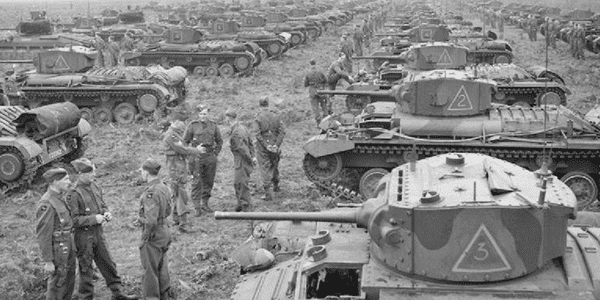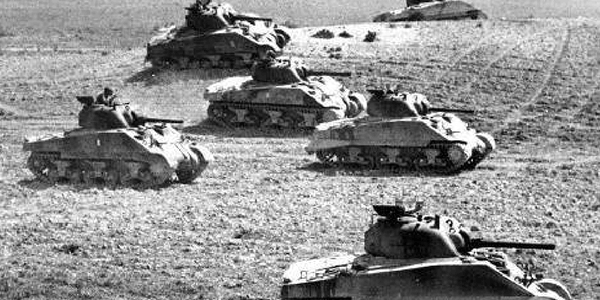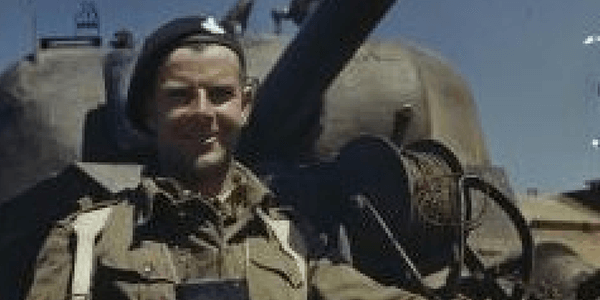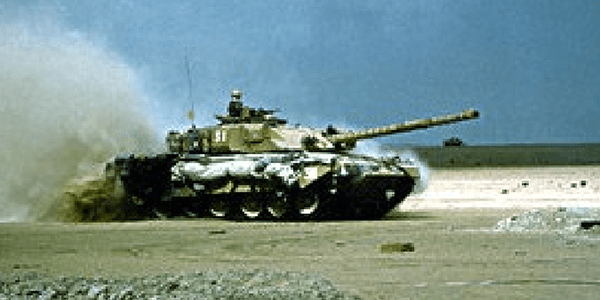17th/21st Lancers
The 17th and 21st Lancers were amalgamated in 1922 to form the 17th/21st Lancers. During the Second World War the Regiment fought in North Africa and Italy. Later the 17thth/21st became part of NATO’s front-line force in West Germany.

Inter-War Years
Having amalgamated at Tidworth, the Regiment quickly established their reputation not only in military proficiency but also on the sporting field. In 1927, after being in use for more than a century, the lance was finally abolished as a weapon of war in the British Army. The 17th/21st Lancers were posted to Meerut, India, in 1930, but it was not until 1938 eleven years after the loss of the lance that the Regiment were first mechanised. The outbreak of war saw the Regiment immediately posted back to England.
After initially being employed as counter invasion forces, they became part of the newly formed 6th Armoured Division, training with Valentine and Matilda tanks. The Regiment remained with the new division in England until 1942 when they were warned off for active service in North Africa.
The Second World War: North Africa 1942-1943
The Regiment eventually deployed to North Africa in November 1942. They were not however initially deployed with the Division but as part of ‘Blade Force’ under Lieutenant Colonel Hull, a 17th/21st Lancer. The plan was that Blade Force would act as a spearhead invasion force into Tunisia. The Force was to move from Algiers, in concert with the 8th Army who were moving west from Egypt, having advanced from El Alamein. The role of the 17th/21st Lancers within Blade Force was to provide a flank guard for the 78th Division, which was to occupy the city. Blade Force made a rapid advance of 300 miles before being held up at the T-roads between Sidi Nasir station and Mateur by strong German resistance. This delay allowed the Germans to reinforce and thus foil the bid to capture Tunis. As a result Blade Force was broken up and the 17th/21st Lancers were returned to 26th Armoured Brigade.

The Fondouk Pass
On the 19th of February 1943, the Germans launched a counter attack into the Kasserine Pass towards Thala. The Brigade was tasked with stopping the German advance. By dawn on the 21st, the Regiment was in a position blocking the road from Thala to Kasserine. All that day it fought a difficult delaying action in which fourteen tanks were lost. At dusk the Regiment retired into a leaguer. After a short time the sound of tanks moving on the road was heard; the enemy had resumed his advance in the dark and led the attack with a Valentine tank which had been abandoned by the Regiment at Tebourba in December. This ruse completely deceived the infantry in front of the regimental leaguer. It was not until the Germans opened fired that anyone realised what had happened. The first person to react was the Adjutant, Captain Ponsonby, who firing the gun of his own tank, destroyed four German tanks in quick succession. Soon the other tanks joined in and three more tanks were destroyed. The German attack dissolved; although the Regiment remained in the area for the next three days, the Germans did not renew it, but retired eastwards.
Protected only by the inferior armour of the Valentine and out gunned by the German tanks, the cost was high. Although the pass was held, the 17th/21st Lancers was reduced to only twelve tanks. It was after this encounter that the Regiment was withdrawn from the line and re-equipped with the American Sherman tank mounting a 75mm gun. This represented a great improvement on the old ‘Tommy Cookers’ (Valentines), both in terms of firepower and armoured protection.
The stage was now set for the Battle of Fondouk, on the 8th and 9th April, in which the Regiment was to play a leading role. The Fondouk Pass was a flat, open plain, 1000 yards wide, dominated on both sides by steep rocky heights. The plan was for the Regiment to break through the pass and cut off the retreating German forces. During a reconnaissance on the evening of the 8th, the Regiment lost four tanks. At 9.00 a.m. on the 9th the 17th/21st was ordered to force the Pass at any cost. The area was mined, and covered by both artillery and anti-tank guns positioned both in the pass and on the high ground. For two hours the Regiment tried to break through the Pass, sustaining such heavy losses that only a handful of tanks were left in action. Information that the dry riverbed to the left might prove to be a way through was passed to Brigade Headquarters. At 11.30, 6th Armoured Brigade ordered the 16th/5th Lancers to try that route, which despite a number of losses to men and tanks, proved successful.
Although the subsequent break-through was achieved, the delay allowed the German forces to retreat unmolested towards Tunis. Regimental losses were eleven killed and thirty-two wounded, with thirty-two tanks put out of action, twenty-seven beyond further use.
May saw the final action of the North Africa campaign with the capture of the Cap Bon Peninsula. The Germans were trying to delay its capture long enough to allow evacuation of their Army by sea. The Regiment conducted a ‘charge’ along the beach totally out manoeuvring the German defensive positions. Enemy resistance crumbled, thousands of prisoners were taken, and thus ended the campaign.
After nine months out of action, March 1944 saw the 17th/21st Lancers, still as part of 6th Armoured Division, deployed to Italy. The North African campaign marked the height of allied armoured warfare. Ahead lay a new country, with difficult terrain that would require new tactics. Even though the dominant role of the tank would no longer be so pronounced, the regiment still played its part to the full in the Italian campaign.
Second World War
At Fondouk in 1943 the 17th/21st Lancers had to break through a heavily defended pass ‘at any cost’.
Riding to War
Sergeant Williams of the 17th/21st in the turret of his Sherman tank during the Second World War
Cold War
The Challenger I tanks used by the 17th/21st Lancers in West Germany fired both high-explosive and armour-piercing shells.
Gulf War
Two squadrons of the 17th/21st deployed against Iraqi forces on Challenger II tanks.

The Second World War: Italy 1944
The Regiment arrived in Italy during the preparation phase for the assault on the Gustav Line, a defensive line running the entire length of Italy and hinged on Monte Cassino. The assault began on 11th May 1944 with the crossing of the River Gari. The 17th/21st moved to their bridge-crossing site ‘Amazon’ during the night only to find that the bridges had not been laid, due to all the engineer bulldozers having been knocked out. As a result the Regiment were forced to improvise, using their tanks to shunt a Bailey Bridge into position and thus effect a crossing. By the 14th the Corps had achieved nineteen crossings and by the 16th the pressure on the Germans proved so great that they were forced to abandon the Gustav Line. It took the Canadians a further five days to breech the Adolf Hitler Line after which the road to Rome was effectively clear.
The advance north of Rome proved itself even harder than in the south. There were only three routes capable of supporting armoured formations with the Germans covering all of them with direct and indirect fire. The delaying action the Germans fought was so effective it took the Allies four months to reach the Gothic Line. The winter of 1944/1945 saw the 17th/21st taking their turn as infantry on the Gothic Line in The Apennine Mountains, not only manning trenches but machine guns and mortars. For the Regiment the battle of The Po Valley proved to be the final action of the war. By VE Day the 17th/21st Lancers had lost 21 officers and 135 other ranks killed.
Greece, Egypt, Palestine 1945-1948
As the Regiment had not deployed from England until 1942 they were not due an immediate return to Britain. As a result, after completing their occupation duties in Austria, they were posted to Greece in October 1946 where they conducted internal security duties and famine relief. In October 1947 the Regiment was sent to the Suez Canal Zone where it was redesignated as an Armoured Car Regiment. From the calm of Suez the 17th/21st were posted to Palestine. At the time Palestine was in a state of civil war, with both Jews and Arabs fighting for independence both from each other and British rule. The Regiment was involved in the operation of armoured rail cars, frontier patrols and escort duties. In the one year that they served in Palestine (1948) the Regiment lost two officers and fourteen other ranks killed.

The Cold War 1953-1989
The main role of the 17th/21st Lancers service after the war was as part of the British Army of the Rhine serving as part of NATO’s conventional deterrent against the Warsaw Pact Armies of Eastern Europe. It also served throughout the world with both squadron and troop deployments to Hong Kong, Borneo, Aden, Libya, Belize, Kuwait and Cyprus.
The main operational commitment post war for the Regiment was in Northern Ireland. Since 1969 and the beginning of the ‘troubles’, the 17th/21st were regularly deployed to the Province in both mounted and dismounted roles. The Regiment was employed in Saladin, Saracen and Ferret armoured cars during the first two and bloodiest years of the troubles. The Regiment also conducted dismounted four-month emergency tours.
The Gulf War 1991
With the Iraqi invasion of Kuwait in 1990 and the deployment of 1st (UK) Armoured Division to the Gulf came the only opportunity for desert warfare since the North Africa campaign of 1943. Although the 17th/21st did not deploy as a Regiment; it did however furnish more than two Squadrons of men and most of its equipment to reinforce the Royal Scots Dragoons Guards and the Queen’s Royal Irish Hussars. The 17th/21st Lancers Band were deployed in their wartime role as medics.
Victory in the Gulf War did not however save the Army from the consequences of the end of the Cold War. Reductions and amalgamations were still implemented in the summer of 1991. The Royal Armoured Corps was reduced from nineteen to eleven regiments. The fate of the 17th/21st was to amalgamate with the 16th/5th Lancers; this was completed by June 1993 when they formed a new Regiment, called The Queen’s Royal Lancers.

